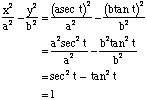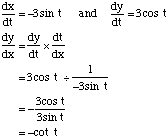|
The conic sections, the circle, the ellipse, the parabola and the hyperbola are not functions. The equations of the conic sections are often written as implicit relations, where y is not the subject, and this makes them difficult to deal with, especially when it comes to calculus and differentiation. To get around this difficulty, a method called parametric equations are used. The x and y variables are each expressed in a much simpler way in terms of a third variable. t or θ are often used. These two equations are functions. CirclesThe parametric equations for the circle x2 + y2 = r2 are:
The circle x2 + y2 = 9 has parametric equations x = 3cos t and y = 3sin t. This can be checked by squaring and adding each equation.
EllipseThe parametric equations for the ellipse
The ellipse ParabolaThe parametric equations for the parabola y2 = 4ax are:
The parabola y2 = 8x has parametric equations x = 2t2 and y = 4t. This can be checked by re-arranging the equations:
HyperbolaThe parametric equations for the hyperbola
These can be checked by squaring and adding: The hyperbola Parametric Equations of Translated Conic SectionsCircles, ellipses, parabolas and hyperbolas that have been translated from the centre point (0, 0) can have parametric equations too.
Differentiating Parametric EquationsOne of the reasons for using parametric equations is to make the process of differentiation of the conic sections relations easier. This concept will be illustrated with an example. Example A circle has the equation x2 + y2 = 9 which has parametric equations x = 3cos t and y = 3sin t Using the Chain Rule: |

